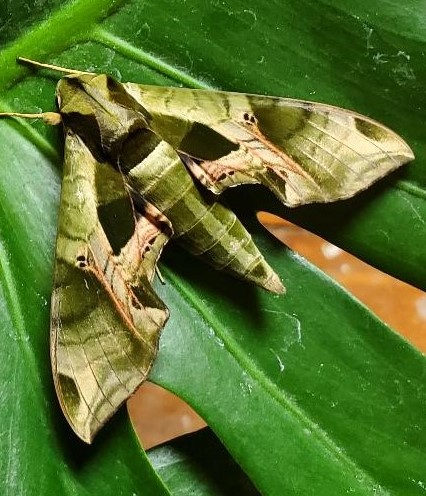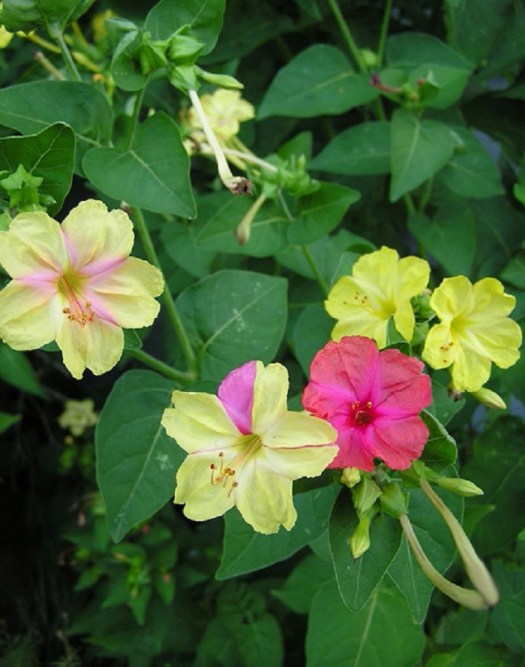As a “person of curiosity,” I’m easily thrown off course when little garden events prompt questions.
On summer evenings in my youth, I was sometimes encouraged to sit on the porch with grownups, to be mesmerized on rare occasions as my great-grandmother’s treasured heirloom “night blooming Cereus” unfurled its large, exotic, fragrant evening flowers. Now that’s a way to hook kids on the mysteries of the garden! And I was also shown some of the creatures that billowed or crept out of the shrubs at night to pollinate those flowers, or to hunt the pollinators.

Anyway, one recent sultry summer evening, watching evening primrose flowers open at dusk and basking in the heady bouquet of four o’clocks in the still night air should have been soothing to my creative right brain. Instead, the interwoven dance of flowers, fragrance, and large, hovering sphinx moths flitting around between newly-opened flowers and avoiding voracious night-feeding geckos, kicked my analytical left brain into overdrive.


Clear-wing “hummingbird moth” pollinates both day and night 
Sphinx moths are too fast for my cameral to capture
One of my so-far unanswered question is, what makes some plants flower at night? In addition to the primrose and four o’clocks, other of my garden’s evening flowers are moonflower vine, angel trumpets (both Datura and Brugmansia) and a scraggly night-blooming cereus (Epiphyllum) grown from a cutting from my great-grandmother; there are more, of course, in gardens of others, plus many daytime flowers that remain open all night (Cleome comes to mind).

On moonflower (photo by James Taylor) 
At rest (photo by Bridget Regan) 
At rest (Photo by Angels Lewis)
Truth is, we still don’t know why they open at night. Best theories are that over thousands of years some plants have adapted techniques for avoiding moisture loss in hot, dry climates; and that some evolved light-colored, fragrant blossoms which open late to attract shy pollinators that venture out at night to avoid predators that are less aggressive in the darkness. Except for those insatiable, lightening-fast geckos, of course, which by the way have gotten rid of ALL the roaches that used to frequent my back garden.

Anyway, while jonesing for explanations to these minor mysteries, I pored over my faded plant physiology class notes, trying to rewrap my old head around long-forgotten technical concepts.

Not to get too technical here, but plants have light sensors, called phytochromes – biological switches that turn night/day responses on and off. Full sun exposes phytochromes to lots of visible red light, which energizes plants into active growth mode; shaded or late afternoon sun has more far-red wavelengths, which tell plants it’s time to transition into night mode.
Here’s how plants tell time: Certain compounds produced during daylight hours break down slowly overnight, enabling plants to chemically “know” how many hours they spend in darkness; yeah, plants tell time by hours of darkness, not hours of daylight. Plus, as nights get successively shorter or longer, plants keep track of this stored information to gradually prepare for changes needed in approaching seasons. Horticulturists take advantage of this by using extra lighting or shading to trick poinsettias, Easter lilies, chrysanthemums, and other holiday flowers to bloom out of season.
The physics are interesting as well: Different stimuli, including temperature and humidity, trigger plants into pressurizing fluids that move into or out of “hinge cells” at the base of leaves and flowers, causing them to get bigger or smaller, longer or shorter. This is what crank flowers to open and close, leaves of some plants to fold and unfold, and stems to bend towards light.
Ah, I can go on and on until our ears start to bleed. I just think that science is so grand! Helps me sort out what’s happening, if not why. But I’ve got to relax now, try to get back to just soaking in the evening garden’s natural sensory allures.
(Sitting on the porch swing, I hear someone murmur “Don’t those four o’clocks smell nice?”)



This post was right up my Alley. Bravo!
LikeLiked by 1 person
Thanks, lady – just savoring the gardening umami, eh?
LikeLike
I absolutely loved this Felder and I absolutely love you. (Don’t worry, I’m a harmless 67 year old grandmother!) I have all of your books and I bought so many copies of Passalong Plants I lost count how many because I loved it so much and I kept telling people about it and SOME people just HAD to have a copy. I have 2 of them here! And I love your new book too. Here’s a question if you answer questions here. Is it possible to grow Night Blooming Cereus here? I’m in Wilmington, NC, Zone 8a? And will Datura survive our winters which are very mild? I have 2 in pots that I bring into my laundry room over the winters and they will even flower inside but I didn’t know if they would survive in the ground here?
Thanks so much. Keep on being you, and oh, I was so sad when Dr. Dirt passed. I loved seeing the videos and hearing the stories about him. And do you still do your radio program? I can’t find it anymore…
All good blessings to you and yours, stay healthy and safe, and “Keep on truckin’!” 😍
Maitri Libellule
LikeLike
thank you so much! my life has been a pleasure… i have replied about your plants via email…
and my NPR radio program is still kicking, live every friday morning and rebroadcast on saturday morning (http://gestaltgardener.mpbonline.org/), and available on podcast: https://tunein.com/podcasts/Arts–Culture-Podcasts/The-Gestalt-Gardener-p49554/
LikeLike